Tsushima's last hero
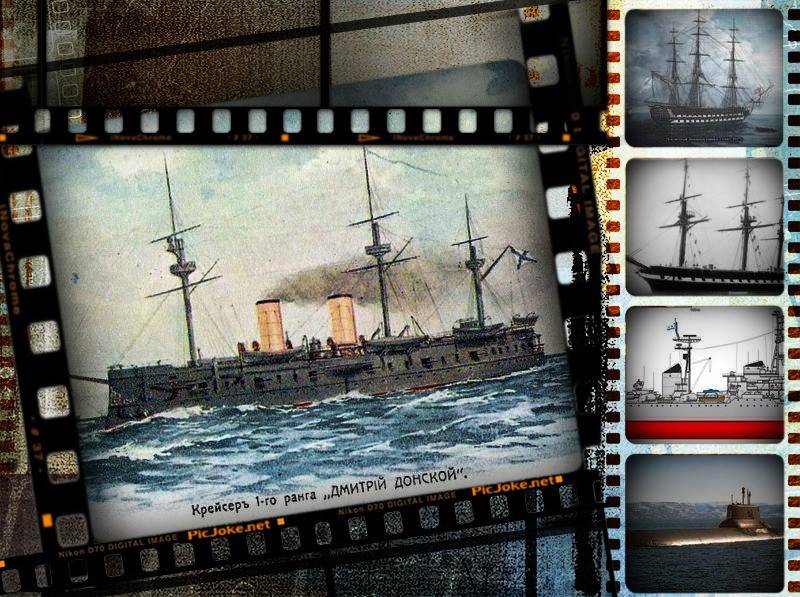
His project was developed by the famous admiral A. Popov and was a development of his own ideas, implemented in the previously built cruisers Minin and General-Admiral, the main functional purpose of which was the extermination of British merchant ships (of course, in the event of the outbreak of war this power).
Since at the end of 1870's. England, to protect its trade, the Shannon and Nelson class cruisers were commissioned; they had impressive armor and strong armament, but a rather low maximum travel speed (12-14 knots), then Russia needed to respond by creating a high-speed ship that had the opportunity to “terrorize” defenseless “merchants” and dodge the battle with stronger enemy cruisers.
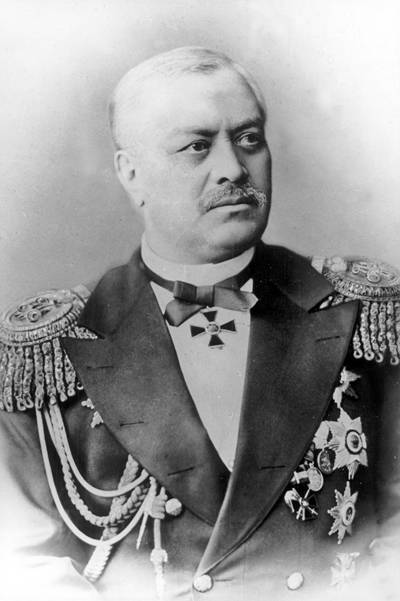
Admiral A.A.Popov
Based on these prerequisites, a draft cruiser with a displacement of 5.75 thousand tons, carrying eight-inch 4 and six-inch 12 six-inch guns, with incomplete armor, the thickness of which ranged from 4.5 to 6 inches, was revealed. The ship was supposed to have a maximum speed of 15-16 nodes and autonomy of at least 30 days, which was extremely important for the successful execution of raider functions.
Having passed a difficult process of coordination by various departments of the Marine Technical Committee, the Marine Ministry and the Admiral General’s office, the project was approved, and in September 1880 a new cruiser was laid on the stocks of the New Admiralty.
The construction of the ship was neither shaky nor shaky, despite the fact that its main builder, N.Ye. Kuteynikov, was a very energetic, educated and experienced craftsman. However, even it was not at all easy for him to cope with the manifold difficulties that arose during construction: interruptions in the supply of essential components and materials from Nevsky, Izhorsky and other factories, an extremely bureaucratic procurement procedure of the state shipyard, which required a lengthy coordination of the purchase of any small items not included in the original estimate (even such elementary as nails and ropes). But the main scourge, of course, was an endless stream of changes to the project, after the start of work.
On the latter circumstance, you probably should stop a little more. The fact is that the practice of constantly making certain improvements and improvements, improvements and simplifications to the ship's design, thanks to which, for example, the most modest BDK “Ivan Gren”, incorporated in the 2004 year, has not yet been accepted into the Navy, has in Russian shipbuilding long traditions that were already quite relevant at the end of the 19 century.
We briefly list what was revised and reworked during the construction of the cruiser, which was named after Dmitry Donskoy on March 28 on 1881 in March:
• the composition and location of the artillery of the main, middle and auxiliary calibers;
• material, configuration and thickness of armor plates;
• screw design;
• steering gear design;
• aft hull design.
Looking at this list, even to a person very far from shipbuilding it is quite obvious that until the moment of final definiteness with this or that construction it was absolutely impossible to continue construction, since they were fundamental for the ship as a whole.
The logical outcome of such an inconsistent approach to the creation of Donskoy was that a number of completely progressive technical solutions applied on it coexisted with obvious anachronisms.
So, for example, the overweight design of the propeller made senseless the presence of traditional masts with a full spar, since sailing became almost impossible due to the resulting retarding effect. And the installation of a modern steam steering gear was not supplemented with a logical installation of the second steering wheel on the front bridge.
Anyway, by the summer of 1885, the construction work on the cruiser was mostly completed. Its displacement was 5,806 tons with the following dimensions: length - 90.4 m, width - 15.8 m, draft - 7.0м.
The armament included two eight-inch guns located in the middle of the upper deck of the cruiser, fourteen six-inch guns encased in a dungeon, eighteen X-mine guns of 37-87 mm caliber and four torpedo tubes.
The maximum speed, demonstrated by Donskoy in testing, was slightly less than 17 nodes. However, the cruiser was unfortunately incapable of supporting it for a long time, because the unsuccessful ventilation system kept the temperature of the air in the stokers so high that the sailors who supplied coal to the fireboxes quickly overworked and could not work with the necessary productivity. .
The side of the ship was protected by ironclad plates, which had a height of 2.24 m, whose thickness varied from 156 mm in the middle part to 114 mm in the extremities. There was also an armored deck with a thickness of 13 mm, which served as additional protection for the cruiser’s engine room and boiler room.
The low and relatively thin armor of the Donskoy could hardly serve the ship as an effective defense against eight- and ten-inch shells of the English cruisers of the Shannon and Nelson types. However, as we remember, according to the idea of its creators, the Russian ship, due to the best speed, had to shy away from a battle with similar opponents. At the same time, his armor probably should have been able to withstand shells with a caliber of six inches and less, which would allow Dmitry Donskoy to feel confident enough in battles with lighter enemy ships, for example, Linder type armored cruisers in the middle of 1880's.
For twenty years after the surrender, the cruiser regularly served Russia in various parts of the world. Three times (in 1885-1887, in 1891-1892, and in 1895), as part of the ship detachments in the Mediterranean, as far as they were concerned, he contributed to the most successful resolution of conflicts involving the definition of the Afghan border, and then with the actions of the British in the Dardanelles.
From 1887 to 1889, in 1892, and from 1896 to 1901. Dmitry Donskoy was on duty at the Far Eastern borders of the country. During this time, the ship visited almost all significant ports of that part of the world, explored the still poorly studied coast of the Russian Primorye, and even took part in suppressing the “rebellion of boxers” in China.
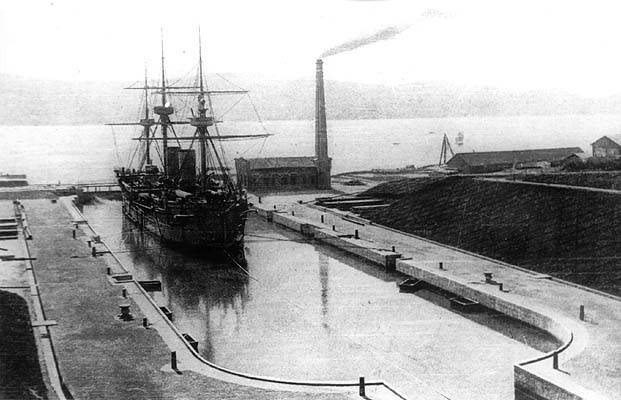
The cruiser "Dmitry Donskoy" in the Vladivostok dock
In addition, in 1893, the cruiser visited New York, where, together with the ships "General-Admiral" and "Rynda", he marched in a naval parade dedicated to the 400 anniversary of the discovery of America by Columbus.
In the intervals between the voyages, the Donskoy was modernized and repaired. For example, in 1889, MTK agreed to dismantle its three heavy masts with subsequent replacement with lighter structures that do not involve the use of sailing equipment. Because of this, the cruiser managed to unload more than 100 tons.
In 1894-1895 the ship underwent a major overhaul, during which its outdated main artillery was replaced: instead of two eight-inch and fourteen six-inch guns, six six-inch and ten Kanet 120-mm guns were installed. At the same time the replacement of the boilers "Donskoy" and the reassembly of its machines was made.
After returning from the Far East to the 1902, the cruiser was actually withdrawn from the fleet combat and converted into an artillery training ship, for which, in particular, part of the 120-mm cannons on it was replaced with 75-mm.
A year later, "Dmitry Donskoy" was included in the squad of Admiral Virenius, sent to replenish the Pacific squadron, based in Port Arthur. Due to the frequent breakdowns of the destroyers traveling with the detachment, its advance was very unhurried. Therefore, by the beginning of the Russian-Japanese war in January 1904, the detachment managed to get only to the Red Sea, from where it was recalled back to Kronstadt. However, in the Baltic, the cruiser was delayed for a short time and in October left it, along with the rest of the squadron ships of Vice Admiral ZP Rozhestvensky.
So, by the will of fate, “Dmitry Donskoy” was forced to return to the Far East in a much more “disabled and weakened” state than the one in which he left him in 1901 (the definition in quotes belongs to the senior officer of the ship, captain of the second rank K. P. Blokhin).
However, during the unprecedented march of the Second Squadron, which had not entered any equipped naval base for eight months, the old cruiser overcame difficulties and, leaving a stern of about thirty thousand kilometers, reached the entrance to 13 in the evening of May 1905. The Korean Strait of the Sea of Japan.
The technical condition of the ship at that time could be considered satisfactory rather arbitrarily. Watch officer, midshipman V.E. Zatursky, showed that "the 5-nd double boiler was strongly flowing and was brought out ... other boilers were also not entirely functional."
According to the report of Rear Admiral O.Enqvist, junior flagship - commander of cruisers, a signal from the squadron commander "on the morning of 14 ..." Dmitry Donskoy and Vladimir Monomakh were ordered to protect the transports in battle, the first on the left and the second on the right. " Thus, Zinovy Petrovich Rozhestvensky severely limited the ability to maneuver his cruisers, linking them with low-speed transport ships.
Approximately in 13: 15, the main forces of the United Fleet were opened from the main armored ships of the Russian squadron. Half an hour later, opponents got close to the 60 cable distance and opened fire on each other.
A detachment of transports arrived in accordance with the only directive issued to him in the event of a battle: “stay on the side of our battleships opposite to the enemy”, and moved to the right side of the column. The Don and Monomachs who escorted them followed the same course.
Approximately forty minutes after the start of the battle, the transports and the ships guarding them (in addition to the two already mentioned above, they included Oleg and Aurora) were attacked by a squad of ten Japanese armored cruisers.
To repel their attacks, Rear Admiral Enquist, who was on the Oleg, decided to build a column of his four cruisers, for which he gave a signal to Monomakh and Donskoy to join the Avrora wake. According to the captain of the second rank, Blokhin: “... only Monomakh managed to enter the wake soon ... Donskoy could not fulfill this signal for some time, thanks to the vehicles that were confused and interfered with maneuvering ...”.
Almost at the very beginning of the battle on the "Donskoy" the steering machine was out of order, and therefore it was necessary to rule on the hand wheel located on the rear bridge of the ship. The control of the machine continued from the front bridge. This circumstance further complicated the conditions for maneuvering, and so hindered by the proximity of transport vessels to them, who, regardless of the risk of collision, in an effort to escape from the enemy’s fire, repeatedly, in a heap of slips, cut through the line of cruisers protecting them.
Because of this, “Donskoy” constantly had to shift the steering wheel, stop the car, or even back up. According to the captain of the second rank of Blokhin, in connection with these constant circulations and changes of the moves, “our shooting is generally bad, it has been done right nowhere.” Obviously, therefore, during the battle that lasted almost four hours, not a single Japanese cruiser was sunk or at least incapacitated. However, Dmitry Donskoy himself also did not receive critical damage.
After six o'clock in the evening, the Japanese cruisers retired. Instead, they appeared enemy destroyers, received orders under the cover of the coming night to conduct torpedo attacks on our ships.
During this period of battle, a convoy of Russian battleships, which had already lost four ships, was heading west. Cruisers and transports were located on its left beam at a distance of about 8 miles.
When the mine attacks began, the battleships, evading them, made a left turn and headed south. In order to give way to them, Rear Admiral Enquist ordered his cruisers to also turn south, believing that in this way he would move along one course with the main forces of the squadron. It is curious that while Oscar Adolfovich did not care at all that their speeds also coincided: at least in the testimony of the senior navigator officer of the Oleg cruiser Captain Second Rank Manturov says that “... we went to the south near 15 - 16 nodes; such a move had until four o'clock in the morning ... ". Therefore, there is nothing surprising in the fact that very soon the “Oleg” and the Aurora that followed him into the wake of the Aurora left not only the battleships, but also the old cruisers - “Monomakh” and “Donskoy”, which, as shown by Rear Admiral Enquist himself , was one of the two quietest ships of the squadron and "gave no more 12 nodes".
About ten o'clock in the evening on the "Donskoy" finally ceased to distinguish between the silhouette of the Aurora who was walking in front. To discuss the plan for further action, the commander of the cruiser, captain of the first rank, N. I. Lebedev, assembled a council on the bridge.
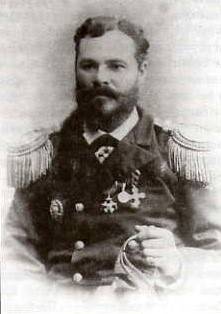
Captain first rank N.I. Lebedev
Surprisingly, none of the officers who took part in it offered to continue moving south in order to leave the zone of domination of the Japanese fleet by morning. On the contrary, everybody unanimously spoke in favor of going to Vladivostok. By a majority of votes, it was decided that they should move to the exit from the Korean Strait along the shores of Japan, which was done.
"Donskoy" turned to the northeast, gradually taking more and more to the north, until it went to the course NO 23⁰.
In spite of the fact that the cruiser was moving with closed lights, after midnight two destroyers were seen, moving the same course as the Donskoy. A little later they were joined by a third. According to the testimony of KP Blokhin, the identification signaling system on the ships of the Second Squadron was poorly developed and poorly mastered, therefore, "... on the Donskoy" they equally hesitated to admit the destroyers who were stern, both for their own and for their enemies. It was decided to follow them strenuously and the night passed in terribly intense attention ... " Fortunately, after sunrise it turned out that all the destroyers were Russian: “Exuberant”, “Poor” and “Terrible”.
At seven o'clock in the morning, all four ships made a long stop, during which Vice Admiral Rozhestvensky and his staff officers rescued from Suvorov were transferred from the heavily damaged Violent to the Pobedovoi. In addition, members of the battleship Oslyabya team, picked up from the water the day before after the death of their ship, were transported from the Violent to Donskoy.
Two hours later, Donskoy and Violent continued on their way (Pobedovy and Grozny went separately to Vladivostok at a higher speed). Around ten in the morning, the destroyer showed a signal to the cruiser that he was in distress and asked to stop. The commander of the Violent, the captain of the second rank Kolomeytsev, who arrived aboard the Donskoy, reported that coal supplies had come to an end on the destroyer, and there were a number of injuries that did not allow him to maintain progress even at 10-11 nodes. In this regard, it was decided to transport the crew of the Violent to the cruiser, and to destroy the destroyer so that he would not get to the enemy.
When only his commander, a mine officer Wurm and a conductor Tyulkin remained on the destroyer, they attempted to blow up the ship, but it was not crowned with success.
In order not to waste time, it was decided to shoot "Violent" from the guns of "Dmitry Donskoy".
This episode should be well known to everyone, even a little interested in the topic of the Tsushima battle, and not least thanks to the novel by A.S. Novikov-Surf “Tsushima”, which, not stint on epithets, painted it as the brightest evidence of depressingly low combat training gunners cruisers, in particular, and the entire fleet, in general.
* * *
Commander Lebedev, who was watching the shooting from the bridge, felt uneasy, was nervous and, finally, when he missed the fourth and fifth time, he angrily exclaimed:
- Ugliness! A shame! A curse hangs over our fleet! All this is the result of what we did not do what we need.
Senior Officer Blokhin explained:
- I have repeatedly argued with our experts, argued to them that they incorrectly train their team ...
The commander interrupted him:
- It's not about individual experts. We must look deeper. The whole organization of service in our fleet is no good.
The sixth and seventh rounds hit the destroyer, and only the eighth hit them thoroughly in his nose.
* * *
An insignificant case revealed the essence of our backward fleet, where people engaged in more parades and not combat training. On a white day, we could not get a single shot at an object at such close range and standing motionless. Such were the gunners from the school created by Rozhestvensky ... "
Considering that Aleksey Silich didn’t have a “Donskoy” on himself, it’s most likely that he wrote the above passage under the impression of KP Blokhin’s testimony, which stated that “in the destroyer who was immobile, in some thirty fathoms from the immobile cruiser, hit only by the sixth shot from the modern six-inch gun ... ”
Not confining himself to a dry description of this fact, Konstantin Platonovich also gave in his testimony rather lengthy arguments that affected the following problems:
• lack of a single approved methodology for training naval gunners;
• confrontation between the flagship specialists of the squadron, on the one hand, and the ship commanders, on the other;
• the arbitrariness of the senior artillery officer of Donskoy, Lieutenant P.N. Durnovo, who, without the consent of the ship’s commander, gave the gunners “obviously false” instructions on how to fire the gun.
The author of this article believes that, on the basis of good intentions, to change the situation for the better, the captain of the second rank, Blokhin, somewhat distorted in his testimony the episode with the shooting of “Violent”: the sixth shot probably did not lead to the first hit in general, but to the first hit that caused significant damage to the destroyer.
The basis for this assumption is the testimony given by the watchman of Donskoy, the midshipman V.Ye. Zatursky, who by the nature of his service was not directly involved in the above-mentioned problems and therefore could be more objective.
“According to“ Violent ”, nine shots were fired from a six-inch gun, from a distance from 2 to 3 cable. One projectile did not hit, the remaining eight, although they did, but most of them did not explode, so 20-30 minutes had passed since the start of the shooting, before the destroyer sank ... ”.
Having lost at least four hours at the stops connected with the transportation of people from the Violent and its execution, on 12: the cruiser Dmitry Donskoy continued towards Vladivostok, which was still about four hundred miles to go.
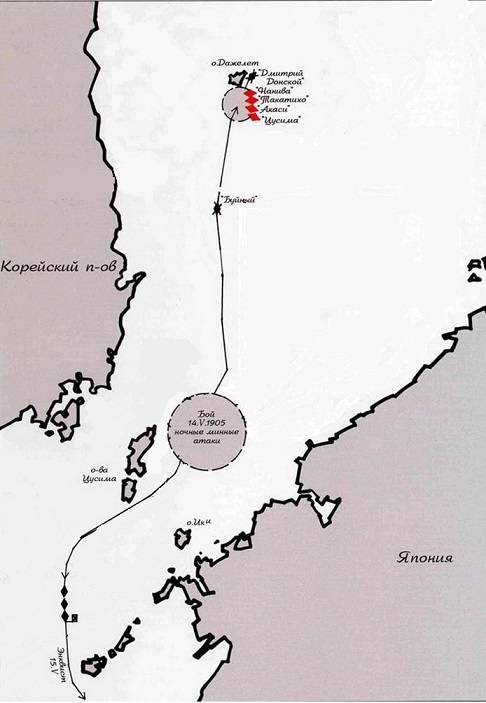
In 16: 30, observers observed smoke from ships moving slightly to the right of the Donskoy course. Attempt to escape from the enemy, taking the left failed. Enemy ships — the Naniwa, Takachiho, Akashi, and Tsushima — accompanied by a division of the destroyers — began the pursuit of the Russian cruiser.
Half an hour later, two more Japanese vessels, the Otova and Niitaka, also accompanied by the destroyers, appeared to the left of the Donskoy course.
All the named enemy ships were armored cruisers with a displacement of no more than 4000 tons, the weapons of which were made by guns with a caliber 156 mm and 120 mm. Each of them individually was weaker than the “Dmitry Donskoy”, but when assembled together they were certainly stronger.
In this situation, it was important that the Japanese ships had a course of at least 17-18 nodes, while the Donskoy, despite the dedicated work of stokers and machinists, could not go faster than 13-13,5 nodes.
When it became obvious that the battle could not be avoided, captain of the first rank Lebedev made a decision to go to the island of Dagelet (Ullyndo), which was still about 35 miles away, and smash the cruiser on its cliff if there is a threat of capture of “Donskoy” by the enemy .
The Japanese signaled on Donskoy several times that the admirals of Nebogatov and Rozhdestvensky surrendered in captivity, and offered to follow their example. The Russian ship did not answer, did not change course and did not reduce the course.
In 18: 30, the Japanese cruisers, marching from the left, reduced the distance from the Donskoy to the 50 cable and opened fire on it. Fifteen minutes later, they were joined by four ships on the right.
The Russian cruiser answered them with a slight delay. According to the testimony of the captain of the second rank of Blokhin, he “twice turned to the commander for permission to break through the combat alarm, but Ivan Nikolayevich thought and was silent; at last he turned to me, with eyes full of tears, but smiling, he shook my hand and said: "If something happens to me, take care of my two little girls." The decision of the commander was obvious to me, and I ordered the alarm to be sounded. ”
The Russian cruiser raised flag flags and opened fire on the approaching Japanese ships.
In the initial phase of the battle, Donskoy tried to maneuver by shooting down the enemy. When the distance was reduced, he went almost directly in order to improve the quality of his shooting.
At this time, getting into frequent and in the "Don". The shells of the Japanese, most likely, were not able to inflict critical damage to the ship’s vehicles or to pierce its side near the waterline protected by armor, but they caused fires in various cruiser premises, produced serious damage to the superstructures, pierced chimneys, reducing the speed of travel, and most importantly incapacitated people. Significant difficulties were delivered to the command of the "Donskoy" by the crew members of the battleship Oslyabya, who almost made a real panic on the ship.
About an hour after the start of the battle, the Japanese managed to get into the front bridge of the cruiser, resulting in the death of the senior artillery officer PN Durnovo, the junior navigator officer NM Girs, and several lower ranks. Commander N. I. Lebedev was also mortally wounded. Command of the cruiser took senior officer KP Blokhin.
"Donskoy" continued to fire at the enemy ships from both sides and quite successfully. Some members of the crew even believed that they managed to sink one of the Japanese cruisers, but, unfortunately, they desired what they wanted: the cruiser Naniwa, which received a serious lurch because of a hole in the underwater part, really got out of battle, but did not sink was going to.
At nine o'clock in the evening, when it was already dark, the cruiser approached the island of Dagelet so much that it became indistinguishable from its background, and this made it impossible to continue its bombardment. Wanting to destroy the stubborn Russian ship at any cost, the Japanese sent destroyers against it, who managed to launch three or four torpedoes, but none of them hit the target.
“Donskoy” was lucky and, according to the testimony of our sailors, as well as the author of the book “The fleet that had to die” (Richard Hou), even sank one or two enemy destroyers.
Around midnight, the battered cruiser approached the eastern tip of the Dagelet Island. By that time, the boilers that had significant leaks and severely damaged chimneys did not allow more than five knots to be developed. Ammunition was almost completely spent. At the closest to the waterline, the holes were flooded with water and therefore, despite the continuous operation of the drainage pumps, it was not possible to eliminate the ship’s substantial lurch on one side. From the crew of the 70 cruiser, a man was killed and around 130 was injured.
Taking into account all of the above, Konstantin Platonovich Blokhin abandoned the idea of continuing to sail to Vladivostok. On his orders, the crew of the cruiser, as well as the sailors of Oslyabi and Violent, were brought ashore, after which the Donskoy was taken a mile and a half from the coast and flooded at a depth of at least two hundred meters.
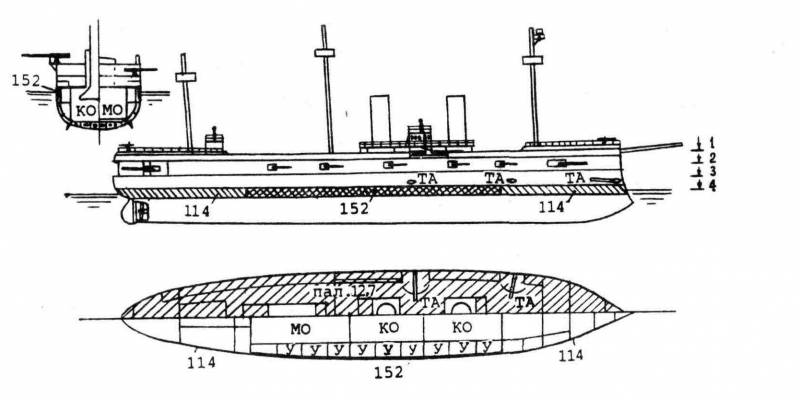
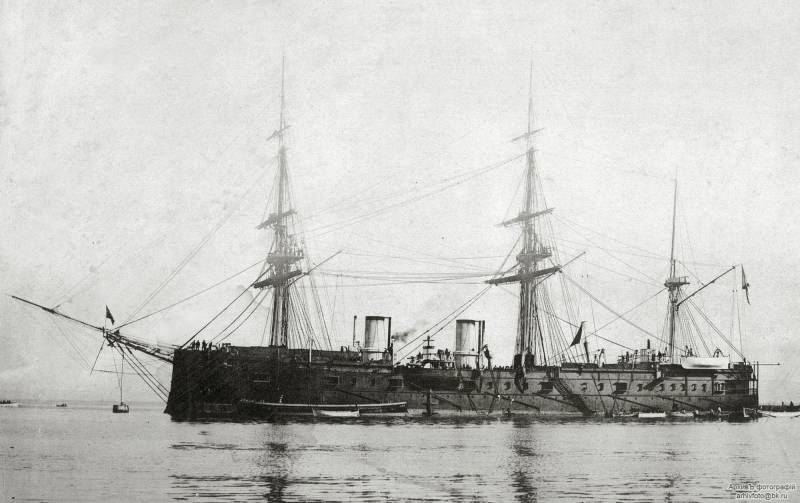
Information